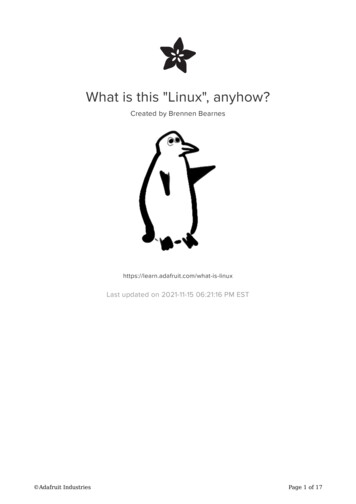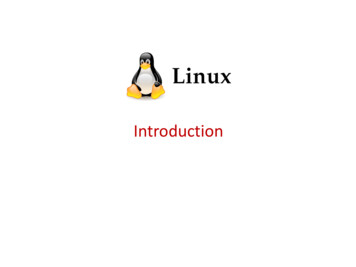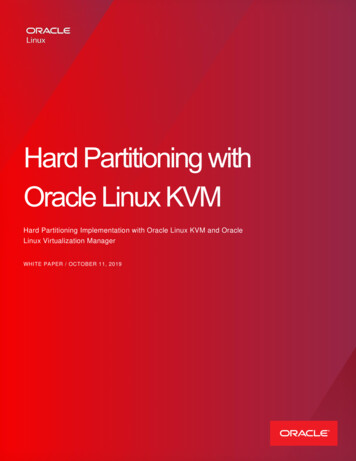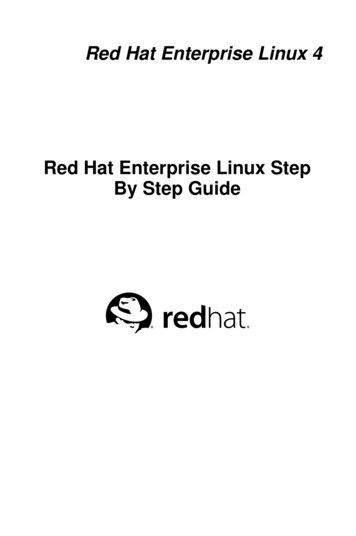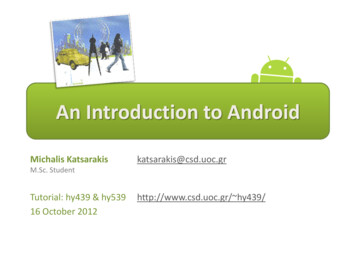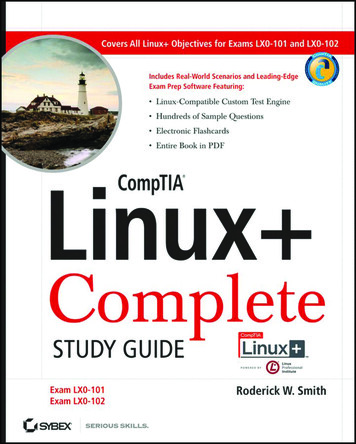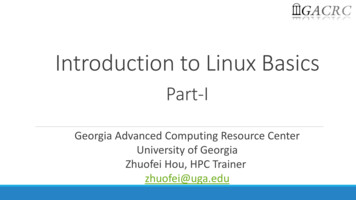
Transcription
Introduction to Linux BasicsPart-IGeorgia Advanced Computing Resource CenterUniversity of GeorgiaZhuofei Hou, HPC Trainerzhuofei@uga.edu
Outline What is GACRC? What is Linux? Linux Command, Shell and Filesystem Concepts Linux Common Commands
What is GACRC?Who Are We? Georgia Advanced Computing Resource Center Collaboration between the Office of Vice President for Research (OVPR) and theOffice of the Vice President for Information Technology (OVPIT) Guided by a faculty advisory committee (GACRC-AC)Why Are We Here? To provide computing hardware and network infrastructure in support of highperformance computing (HPC) at UGAWhere Are We? http://gacrc.uga.edu (Web)http://wiki.gacrc.uga.edu (Wiki) https://wiki.gacrc.uga.edu/wiki/Getting Help (Support) https://blog.gacrc.uga.edu (Blog) http://forums.gacrc.uga.edu (Forums)
GACRC Users September 2015Colleges & SchoolsFranklin College of Arts and SciencesCollege of Agricultural & Environmental SciencesCollege of EngineeringSchool of Forestry & Natural ResourcesCollege of Veterinary MedicineCollege of Public HealthCollege of EducationTerry College of BusinessSchool of EcologySchool of Public and International AffairsCollege of PharmacyCenters & InstitutesDepts149114223112409TOTALS: 0102235970591029
GACRC Users September 2015Centers & InstitutesPIsUsersCenter for Applied Isotope Study11Center for Computational Quantum Chemistry310Complex Carbohydrate Research Center628Georgia Genomics Facility15Institute of Bioinformatics11Savannah River Ecology Laboratory39Skidaway Institute of Oceanography22Center for Family Research11Carl Vinson Institute of Government121959
What is Linux? What is Operating System (OS)? What is Linux OS? Brief History of Linux OS Why Linux OS?
What is Linux – Operating System Operating System (OS) : Program initially loaded at booting time, to manage all the otherapplication programs on a computer Software interface between computer hardware and its human user Needed for ALL computers to be operated Needed to run software and control hardware Popular OSes:
What is Linux – Linux OS Linux OS is a full-fledged OS with 4 major parts:I. Kernel: Low-level OS, handling files, disks, RAM, networking, etc.II. Supplied Programs: Web browsing, Audio, Video, DVD burning III. The Shell: A command-line user interface for a user to type andexecute commands: Bourne Shell (sh) Korn Shell (ksh) C Shell (csh) Bourne-Again Shell (bash) Linux default shellUNIX standard shellsIV. X: A graphical system providing graphical user interface(GUI)
What is Linux OS – Brief History Originally was a kernel only, nothing else Combined with the various software and compilers from GNUProject to form an OS, called as GNU/Linux OS:Linux Kernel GNU Components GNU/Linux OS Linux OS So, History of Linux History of Linux Kernel History of GNUNextPage
What is Linux OS – Brief History of Linux Kernel Developed in 1991 by Linus Torvalds, a second yearstudent, at the University of Helsinki, Finland Developed as a clone of UNIX OS, which is cheaper, canrun on PC, and is nonproprietary Linux 0.02 released in 1991 consists of only the kerneland 3 utilities: Bash : a command-line interface (CLI) update : a utility to flush file system buffers gcc : a C compiler
What is Linux OS – Brief History of GNU Project Started in 1983 by Richard Stallman. Launched in1984 with a mission to develop a complete UNIX-likeOS which is FREE for copying and modification GNU means “GNU's Not Unix” However, NO functional kernel developed by GNUitself Linux kernel was the BEST fit as the kernel for theGNU Project, SO
What is Linux OS – Brief History Today, Linux OS is used by millions and available in theform of various Linux distributions: Linux is the most used OS on servers: As of February 2010, 6 out of 10 most reliable web hosting companies As of November 2014, 485 (97%) out of top 500 supercomputers Linux OS is supported by many big companies, such as IBM, Google,Sun, Novell, Oracle, HP, Dell, etc.(Data are cited from http://en.wikipedia.org/wiki/Linux)
What is Linux OS – Why Linux? Viruses FREEVery STABLEFREE Linux OSNever gets slowNo need to defrag hard diskHighest degree to customize user’s working environmentComes with most of the required software pre-installedUpdate all software with minimum labor
Linux Command, Shell and Filesystem Concepts What is a Command? What is a Shell? What is Filesystem?
Linux Command, Shell and Filesystem What’s a Command A Linux command typically consists of a programfollowed by command options and arguments, typed within a shell:shell prompt wc –l –wprogramfile115 wc –lwfile1file2argumentcombined commandoptionscommandoptionsOutput:OR86# of lines # of file2total
Linux Command, Shell and Filesystem What’s a Command A Linux command typically consists of a programfollowed by command options and arguments, typed within a shell: 3 general formats of command options:i.with no value : wc –l -wii. with a value:blastx –thread 4iii. combined:wc -lw 5 Tips:i.Linux command is ALWAYS case sensitive!ii. Press TAB key to autocomplete a command or filename Auto-completioniii. Press and arrow keys to look up previous commands Command historyiv. Press CTRL c to terminate a commandv. How to use a command? Use command option --help, e.g., wc --help Use man command, e.g., man wc
Linux Command, Shell and Filesystem What’s a Shell A place to type and run commands on a Linux system: Command-line user interface for typing commands Command interpreter to interpret & run commands Programming environment for scripting Linux default: Bourne-Again Shell (bash) To open a shell on:Local Linux/MacTerminal (a utility)Local WindowsCygwin (a Linux emulation layer)Remote Linuxa shell will run immediately when log inby SSH Secure Shell Client or PuTTy
Linux Command, Shell and Filesystem What’s Filesystem A internal data structure that OS uses to organizefiles on disk: Tree-structured & hierarchical Topmost directory: root directory (/) Each directory has one parent(except for /),may contain 0 or more subdirectories Files are collected in directories Files and directories are accessed by path:path 1: /home/mkl/mystuff/stuffpath 2: /usr/local/ A path beginning with /: an absolute path
Linux Command, Shell and Filesystem What’s Filesystem A internal data structure that OS uses to organizefiles on disk: Two special directories:. (a single dot) : your current directory. (two dots in a row) : parent directoryE.g. If current directory is /home/mklpath 1: go . go /home/mklpath 2: go . go /homepath 3: go ./other go /home/otherpath 4: go ././usr go /usr A path not beginning with /: a relative path
Linux Command, Shell and Filesystem What’s Filesystem A internal data structure that OS uses to organizefiles on disk: Filename naming convention:i. Good characters: A Z or a z, 0 9, (Underscore), . (Period), - (Dash)ii. Bad characters: special characters, e.g., , *, ?, /, , #, &, , and whitespaceiii. Linux filename is ALWAYS case sensitive!iv. Not like Windows, no file extension needed in Linux!v. Max length of a filename is usually 255 characters Examples:i. Good: matrixdata1, matric data 1, matrix.data.1, testFile, 20150720, etc.ii. Bad: xy*z, x y, myfile, matrix data, datafile&, matrix data, etc.
Linux Common Commands Basic File OperationsDirectory OperationsFile ViewingOtherPlease do NOT do commandpractice on Login node ofGACRC clusters!(For more complete list, please refer to GACRC Wiki:https://wiki.gacrc.uga.edu/wiki/Command List)
Linux Common Commands – Basic File Operations ls : List files and subdirectories in a directory cp : Copy a file into another or a directory mv : Rename or move a file into a directory rm : Remove a file
Linux Common Commands – Basic File Operations ls : List files and subdirectories in a directoryls -lList files with a long information listingls -aList all files, including hidden configuration files, whose names begin with a dot,called as “dot files”ls -hList files with sizes in human readable formatls -lhCombination of -l and -hzcluster ls -lha-rw-r--r-1drwxr-xr-x 2-rw------1-rwxr-xr-x 402188K252131Jul 16 10:06Jul 16 10:05Jul 16 10:05Jul 16 10:05Jul 16 10:05Jul 16 10:05.bashrcdatahello1.chello1.xREADMEsub1.sh dot file subdirectory C source code C binary readme file shell script
Linux Common Commands – Basic File OperationsFile Type# of Hard LinksFile labUserGroup188KLast Modification TimeFile NameJul 16 10:05hello1.xGroupFile Type: for Regular FilePermissions: r for Read (4)d for Directoryw for Write (2)User: (r w x) 7Other: (r x) 5Group: (r x) 5x for Execute (1)To change permissions:chmod commandhello1.x is a regular file withpermissions of 755
Linux Common Commands – Basic File Operations cp : Copy a file into another or a directorycp file1 file2Copy a file into anothercp file directoryCopy a file into a directorycp –i file1 file2Copy with interactive mode, ask before overwritingzcluster cp hello1.c hello2.c hello2.c is a new file copied from hello1.czcluster cp hello1.c ./data ./data is a subdirectoryzcluster cp -i hello1.c hello2.ccp: overwrite hello2.c'? nzcluster interactive mode is always safe!
Linux Common Commands – Basic File Operations mv : Rename or move a file into a directorymv file1 file2Rename a filemv file directoryMove a file into a directorymv –i file1 file2Move with interactive mode, ask before overwritingzcluster mv hello1.c hello2.c hello2.c is the file renamed from hello1.czcluster mv hello1.c ./data ./data is a subdirectoryzcluster mv -i hello1.c hello2.cmv: overwrite hello2.c'? nzcluster interactive mode is always safe!
Linux Common Commands – Basic File Operations rm : Remove a filerm fileRemove a filerm –i fileRemove with interactive mode, ask before deleting a filezcluster rm hello2.c hello2.c is removed from current directoryzcluster rm -i hello2.crm: remove regular file hello2.c'? nzcluster interactive mode is always safe!
Linux Common Commands – Directory Operations cd : Change your current working directory pwd : Print absolute path of your current working directory mkdir : Create a directory rmdir : Delete an empty directory rm –r : Delete a nonempty directory and its contents
Linux Common Commands – Directory Operations cd : Change your current working directorycd dirnameChange to the dirname directoryzcluster cd ./date change to a subdirectory ./datazcluster cd . change to parent directoryzcluster cd /test change to a subdirectory ./test in home directory ( )zcluster cd /home/abclab/jsmith/test an absolute path is used! pwd : Print absolute path of your current working directoryzcluster pwd/home/abclab/jsmith/test/data an absolute path is printed!
Linux Common Commands – Directory Operations mkdir : Create a directorymkdir dirnamezcluster mkdir data1Make a directory with the name of dirname Create a subdirectory in current working directory rmdir : Delete an empty directoryrmdir dirnamezcluster rmdir data1Remove an empty directory data1 is an empty directory! rm –r : Delete a nonempty directory and its contentsrmdir –ri dirnamezcluster rm -ri data1Remove with interactive mode, ask before removing interactive mode is always safe!
Linux Common Commands – File Viewing cat : Print files to standard output, concatenating them less : View text files, one screen at a time, scroll down/up more : View text files, one screen at a time, scroll down only
Linux Common Commands – File Viewing cat : Print files to standard output, concatenating themcat filePrint contents of file1 to standard outputcat file1 file2Print contents of files to standard output, concatenatingthemzcluster cat file1Hello, this is file1.zcluster cat file2Hello, this is file2.zcluster cat file1 file2Hello, this is file1.Hello, this is file2. print contents of file1 print contents of file2 print contents of file1 and file2 with concatenation
Linux Common Commands – File Viewing less : View text files, one screen at a time, scroll down and upless fileView text one “page” at a time, spacebar to scroll down,key b to scroll up, key q to quitzcluster less file1 more : View text files, one screen at a time, scroll down onlymore filezcluster more file1View text one “page” at a time, spacebar to scroll down,
Linux Common Commands – Other file : Determine the type of a file dos2unix : Convert DOS/Windows file to Linux format mac2unix : Convert Mac file to Linux format
Linux Common Commands – Other file : Report the type of a filefile file1Report the type of the file file1zcluster file data directory ./datadata: directoryzcluster file hello1.c programming language source file hello1.chello1.c: ASCII C program textzcluster file hello1.x executable file hello1.xhello1.x: ELF 64-bit LSB executable, AMD x86-64, version 1 (SYSV), for GNU/Linux 2.6.9,dynamically linked (uses shared libs), not strippedzcluster file README ASCII text file READMEREADME: ASCII textzcluster file sub1.sh shell script sub1.shsub1.sh: Bourne-Again shell script text executable
Linux Common Commands – Other dos2unix : Convert DOS/Windows file to Linux formatdos2unix file1Removes DOS/Windows line endings in file1zcluster dos2unix file1 mac2unix : Convert Mac file to Linux formatmac2unix file1zcluster mac2unix file1Removes Mac line endings in file1
Thank You!
Jan 13, 2016 · Linux Command, Shell and Filesystem What’s a Command A Linux command typically consists of a program followed by command options and arguments, typed within a shell: 3 general formats of command options: i. with no value : wc –l -w ii. with a value: blastx –thread 4 iii. combined: wc -lw 5 Tips: i.




